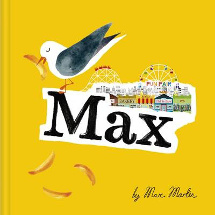Max by Marc Martin

Penguin, 2014. ISBN 9780670077434.
Max and Bob are great mates. They live by the sea and during the
day, Max keeps Bob company in his fish and chip shop (Max loves both
fish and chips so it's a perfect partnership) and in the evening
they go fishing together.
How can that scenario make for a most enchanting story that kept 9
and 10 year-olds engaged for over an hour and wanting more?
Well, Max is a seagull, who's a little bit cheeky and a little bit
mischievous, and this is the story of a friendship that endures even
after Bob has to close his shop because of a lack of business. When
Max comes to the shop one morning, Bob has gone, and even though he
waits and waits and waits, his friend does not return. Without Bob
there is no attraction for Max and so he decides to leave - but as
he flies high over the city looking for another home he smells a
familiar smell . . .
Marc Martin won the 2013 Crichton Award for Australia's best new
illustrator and the illustrations for 'Max' add so much to its
message and its charm. Using a variety of techniques, vignettes and
full-page spreads, (the class laughed out loud at Max sitting on top
of the No Seagulls sign) they are rich and exquisite, providing so
many more layers to the story than just the text alone. For example,
while there is no written explanation for the downturn in business,
the picture of cranes soaring high above the funfair, the main
drawcard of the area, tells its own story and opened up a discussion
about the impact of tourism on local economies (particularly
pertinent where I live). Later, the reason for the dismantling for
the funfair is also evident and sparked a debate about 'you can't
stop progress'. What seems like a simple tale for a preschooler to
enjoy is so much more.
As well as an enthusiastic discussion that ranged from personal
stories of feeding seagulls hot chips, recalling other seagull
stories we've read such as The Lighthouse Keeper's Lunch and
Samantha Seagull's Sandals to the importance of the snow-oriented
industry on our region, to country versus city living, the students
also embraced the task of imagining what Max would have seen as he
flew over our town and then drawing a birds-eye view map of it.
Suddenly that concept made sense to them! What started as a story to
share because I loved it became a rich and rewarding experience for
all of us that went far beyond the focus and timeframe I'd
allocated. But when you're on a good thing . . .
Barbara Braxton